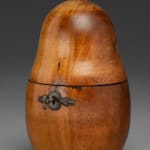Early 19th Century Fruitwood Tea Caddy in the form of a Pear
POSSIBLY CONTINENTAL, CIRCA 1800
17.8 x 10.2 cm
7 x 4 in
7 x 4 in
7017
The turned fruitwood caddy with the original stalk, a shaped iron escutcheon, iron hinge and lock. The interior with the remains of the original foil lining and visible pin marks...
The turned fruitwood caddy with the original stalk, a shaped iron escutcheon, iron hinge and lock. The interior with the remains of the original foil lining and visible pin marks to the inner rims of the lid and body, which were used as reference points for the maker to align the two sections precisely when fitting the hinge. The base with the remains of blue paper.
Edward H. Pinto writes in 'Treen and other wooden bygones' (Bell & Hyman, 1979) 'European fruit caddies - pears, apples and canteloupes - are hinged on a horizontal line about five-eighths of the way up, are fitted with a lock, have, or have had, foil linings and an inner lid ; the stem is inserted as a separate component.' Examples are illustrated in Fig 338.
Examples are also illustrated in 'The Story of British Tea Chests and Caddies - Social History and Decorative Techniques' (ACC Art Books, 2022, p. 131 fig. 5.118). Anne Stevens and Gillian Walkling write 'Unlike other caddies which commonly have brass or silvered metal hinges, most fruit caddies have a single iron or steel hinge, that is usually shaped to fit the curved profile of the rim. The small escutcheons are mostly of the same metal as the hinge.' (p. 132).
In 'Tea and Taste - The Visual Language of Tea' (Schiffer, 2004), Tania M. Buckrell Pos states that 'The exquisite patina and and novelty of their shapes have made fruitwood caddies particularly collected in today's market.'
Edward H. Pinto writes in 'Treen and other wooden bygones' (Bell & Hyman, 1979) 'European fruit caddies - pears, apples and canteloupes - are hinged on a horizontal line about five-eighths of the way up, are fitted with a lock, have, or have had, foil linings and an inner lid ; the stem is inserted as a separate component.' Examples are illustrated in Fig 338.
Examples are also illustrated in 'The Story of British Tea Chests and Caddies - Social History and Decorative Techniques' (ACC Art Books, 2022, p. 131 fig. 5.118). Anne Stevens and Gillian Walkling write 'Unlike other caddies which commonly have brass or silvered metal hinges, most fruit caddies have a single iron or steel hinge, that is usually shaped to fit the curved profile of the rim. The small escutcheons are mostly of the same metal as the hinge.' (p. 132).
In 'Tea and Taste - The Visual Language of Tea' (Schiffer, 2004), Tania M. Buckrell Pos states that 'The exquisite patina and and novelty of their shapes have made fruitwood caddies particularly collected in today's market.'




